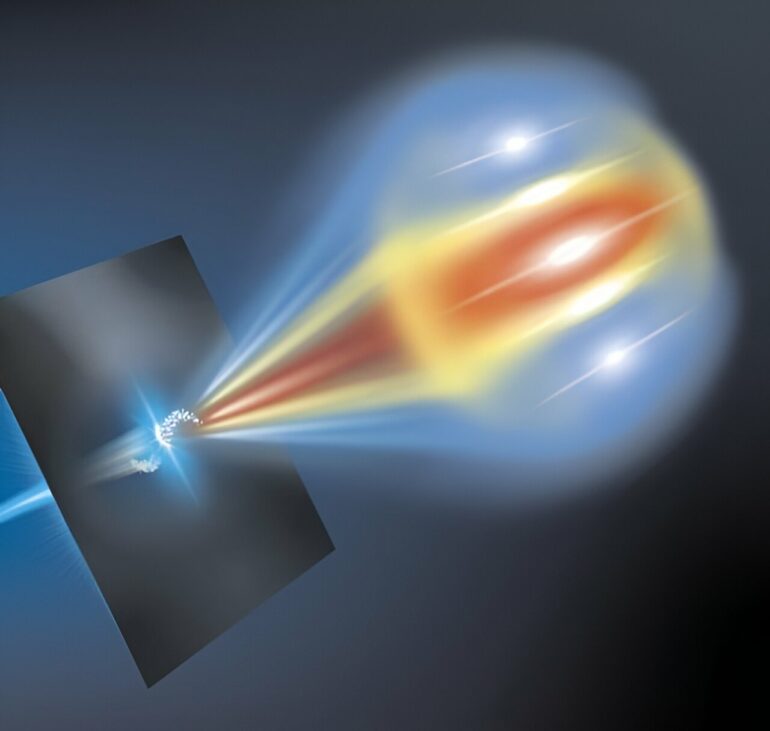Laser-plasma accelerators take up less space than conventional facilities, which are sometimes kilometers long. Such compact particle sources can accelerate electron bunches efficiently, enabling X-ray lasers that fit in the basement of a university institute.
But there are a few challenges to be met: in order to produce UV or X-ray light, the electron bunches generated by a laser-plasma accelerator must be very finely bundled and have defined properties.
To date, it has been difficult to even measure these bunches precisely. Now, a team at Helmholtz-Zentrum Dresden-Rossendorf (HZDR) has developed a novel measuring method that should help to drive the development of laser-plasma acceleration.
In laser-plasma acceleration, a laser shoots intense light pulses into a gas. The pulse is so strong that it ionizes the gas and generates a plasma—a mixture of electrons and ions. As the laser pulse forces the lighter electrons out of the way more quickly than the heavier ions, an electrically positively charged “bubble” forms behind it. If some electrons are injected into this bubble, the strength of the electro-magnetic field can virtually catapult them forward.
This process only requires a few centimeters but can accelerate the electrons bundled in bunches as much as a conventional set-up that measures dozens or even hundreds of meters and uses radio waves to get the particles moving.
The free electron laser (FEL) is an interesting application for state-of-the-art laser-plasma accelerators. Here, electron bunches fly through a so-called undulator at nearly the speed of light. This array of magnets forces the particles onto slalom paths, making them emit strong, laser-like X-ray or UV flashes, which can be utilized to track extremely fast processes like chemical reactions that take place in quadrillionths of a second.
Compact and cost-effective
There are now several of these research machines, including the European XFEL in Hamburg. They are based on conventional linear accelerators, some of which are several kilometers long. But, so far, these facilities are rare and thus the available beamtime is limited. If FELs could be constructed on the basis of laser-plasma accelerators, the facilities could be built so compactly and cost-effectively that a university institute, for instance, would be able to afford one. The technology would thus become available to far more research teams than at present.
Initial successes have already been achieved: since 2021, three research groups have managed to demonstrate that an FEL based on plasma accelerators can be implemented—a team in Shanghai, China, a group in Frascati, near Rome, and a team working with the physicist Dr. Arie Irman at HZDR’s Institute for Radiation Physics.
In a review article in the journal Nature Photonics, those involved summarize the current state of development and itemize the outstanding research questions.
“Among other things, we have to improve the quality and stability of the accelerated electron bunches and minimize the distribution of the electrons’ energy within the bunches,” explains Irman, one of the authors of the paper. “But it is also important to develop new diagnostic methods in order to investigate the processes in a laser-plasma accelerator more precisely.”
Electron bunches traverse foil
This is where the new HZDR project comes in: Dr. Maxwell LaBerge, a postdoc in Irman’s Team, has developed a measuring procedure that allows scientists to analyze in detail extremely short electron bunches measuring just a few micrometers. The paper is published in the journal Nature Photonics.
LaBerge explains, “We shoot the electron bunches, almost at the speed of light, from the plasma accelerator onto a thin metal foil. This sets the electrons on the surface of the foil in motion.”
As a result, these electrons send a signal—rather like a transmitting antenna—that can be detected by sensors. “Using this signal, we can precisely reconstruct what the electron bunches that have traversed the foil look like,” says LaBerge, describing the process, the technical term for which is Coherent Optical Transition Radiation (COTR).
HZDR’s experts have used their new measuring method to explore different ways of injecting the electrons into the plasma bubble. Irman states, “We’ve been able to ascertain that different injection methods produce quite different forms of electron bunches, which shows that the new method can help to control the form and structure of the electron bunches much more precisely.”
And the better the control over the speedy electron bunches, the brighter and more stable the light they produce in an FEL.
More information:
M. Galletti et al, Prospects for free-electron lasers powered by plasma-wakefield-accelerated beams, Nature Photonics (2024). DOI: 10.1038/s41566-024-01474-3
Maxwell LaBerge et al, Revealing the three-dimensional structure of microbunched plasma-wakefield-accelerated electron beams, Nature Photonics (2024). DOI: 10.1038/s41566-024-01475-2
Provided by
Helmholtz Association of German Research Centres
Citation:
Researchers present new diagnostic tool for laser-plasma accelerator using metal foil as 3D scanner (2024, August 30)



